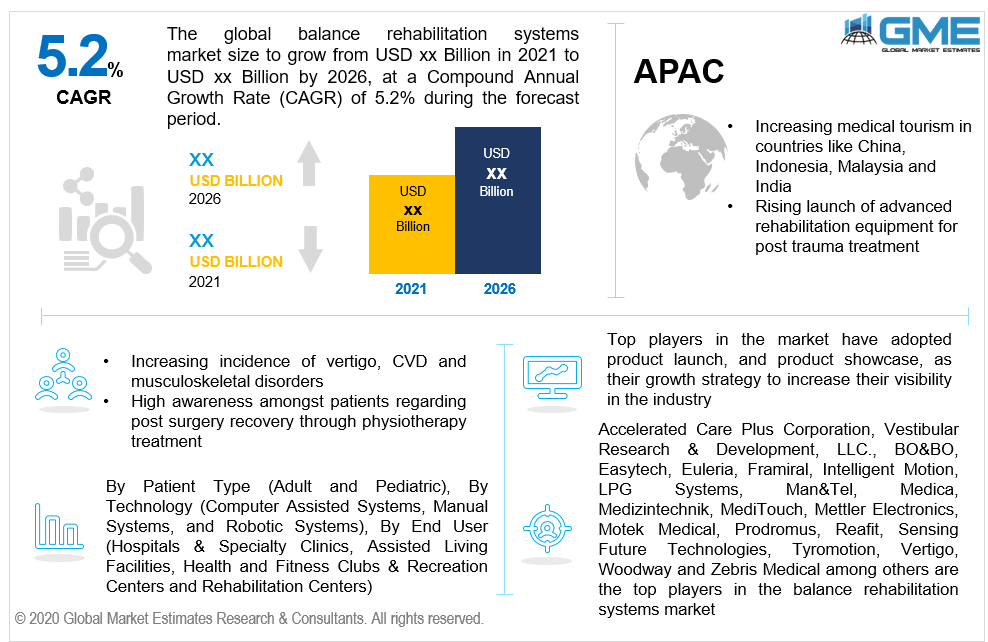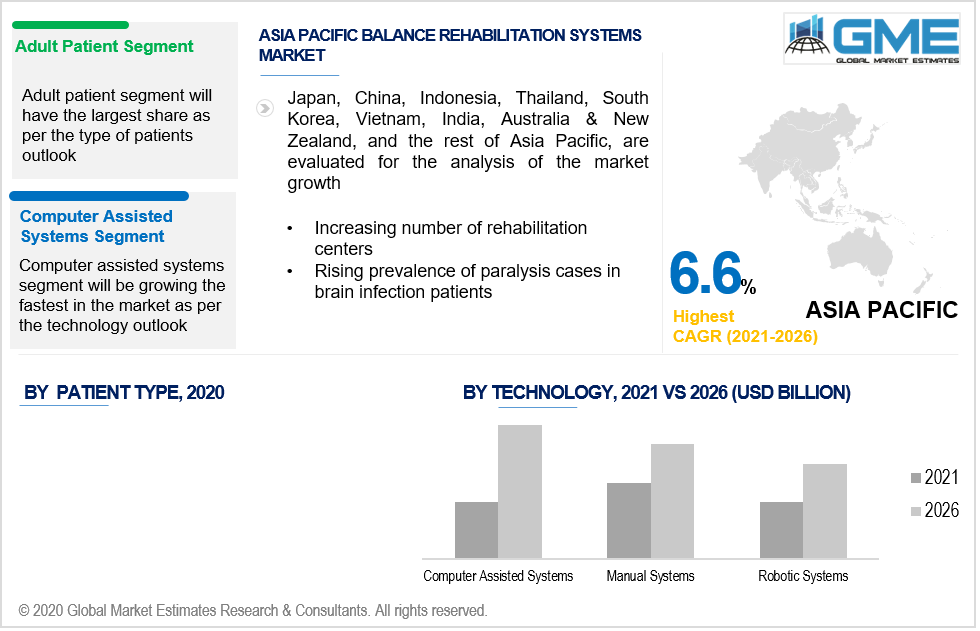
Global Balance Rehabilitation Systems Market Size, Trends & Analysis - Forecasts to 2026 By Patient Type (Adult and Pediatric), By Technology (Computer Assisted Systems, Manual Systems, and Robotic Systems), By End User (Hospitals & Specialty Clinics, Assisted Living Facilities, Health and Fitness Clubs & Recreation Centers and Rehabilitation Centers), Competitive Landscape, Company Market Share Analysis, and Competitor Analysis
Popularly known as vestibular rehabilitation therapy system, the balance rehabilitation system is a dedicated and specific exercise-based program, designed by a vestibular therapist, in order to improve posture and balance and also reduce problems related to dizziness in patients recovering from post cerebral palsy stroke, paralysis attack, and any chronic musculoskeletal injury. Patients suffering from chronic heart failure (CHF), Parkinson’s disease, muscle disuse atrophy, and chronic obstructive pulmonary disease (COPD), are recommended to use such equipment. Such systems allow the therapist to work with their patients freely, and improve the individual treatment process. Such systems help the patient work on their posture and stability, and smoothly with gradual progress guaranteed. The specific function or application of such systems is to perform standing tolerance, balance, and pre-gait exercises.
Increasing incidence of vertigo cerebral palsy (as per NIH 2017, the prevalence of cerebral palsy is 2 cases per 1,000 live births), increasing healthcare expenditure on advanced treatment equipment, high risk of infection across both developed and developing regions, and high prevalence of geriatric population will help drive the global balance rehabilitation systems market. Moreover, increasing cases of viral infections, infection-causing brain injury, and rising cardiovascular complications amongst geriatric and bariatric patients will propel the market growth. Rising awareness regarding advanced technology for the post-recovery stage and increasing initiatives taken by the government to promote physical therapy as a treatment option will boost the market demand. As per the University of California San Francisco Health (UCSF Health), more than 40% of the United States population experiences vertigo at least once in their lifetime. It also estimated that this disorder has a high chance to be affected by women more than men. Hence, the prevalence of other diseases too is witnessed more in children, geriatric patients, and the female population as compared to the male population. Hence, the market is ought to be growing rapidly owing to the importance of post-trauma surgery amongst most of the patient categories in developed and developing nations.
Besides, stroke is one of the leading causes for patients opting for balance rehabilitation therapy. As per the latest data provided by CDC (Center for Disease Control and Prevention), in 2018, cardiovascular stroke was responsible for 1 in every 6 deaths. In 40 seconds a person faces complications of a stroke in the United States and every 4 minutes a patient dies of a stroke. Moreover, as of 2019, there are more than 795,000 people in the United States living with this disease.

Based on the type of patient, the market can be segmented into adult and pediatric patients. The adult patient segment will be the largest in the market in terms of revenue generation or market value and the pediatric patient segment will be growing the fastest. The major reason behind the high growth is that most of the children across the globe are a victim of most of the musculoskeletal disorders.
Based on technology, the market can be segregated or split into computer-assisted systems, manual systems, and robotic systems. The manual systems will be the largest market in terms of market value. However, in terms of growth rate, the leading segment will be the computer-assisted balance rehabilitation systems. Computer-assisted balance rehabilitation systems are equipped with a computer and other smart devices that are for the home healthcare setting. Such therapy is prescribed for a maximum of three months at a stretch and does not require the help of any healthcare worker. Hence, computer-assisted systems will be the fastest-growing segment owing to rising patient-centric and at-home therapy trends for post-recovery management.
The market can be classified based on the end-user or consumer. The market is split into hospitals & specialty clinics, assisted living facilities, health, and fitness clubs & recreation centers, and rehabilitation centers. The rehabilitation center will be the largest segment in the market as of 2021. Also, the 2nd largest segment of this market will be the hospital & specialty clinics. With the increasing number of cases registered in a rehab center, for post-stroke, post-trauma, post-surgery, and vertigo, the market for a rehabilitation center is ought to grow. Also with the increasing number of rehab centers as compared to hospitals and clinics in developing countries such as China, India, Malaysia the rehab center segment is estimated to be dominant for the forecast period too.

As per the geographical analysis, the market of digital medical dynamometer can be classified into North America (the United States, Canada, and Mexico), Asia Pacific (India, China, Japan, Malaysia, Singapore, and Rest of Asia Pacific), Europe (Germany, United Kingdom, Italy, France, Spain, Netherlands, and Rest of Europe), Middle East & Africa and Central South America. The United States, Canada, and Mexico are the largest homes to stroke, cardiovascular disorder, and vertigo patients. Also, balance rehab systems are the advanced equipment available first hand in the U.S. as the regulatory scenarios and reimbursement scenarios are quite favorable. Hence, owing to these factors, the market for North America will be the largest amongst all as of 2021. However, with increasing medical tourism activities and rising cases of cardiac diseases in the Asia Pacific countries, the market for APAC will be growing tremendously with the highest CAGR value from 2021 to 2026.
Accelerated Care Plus Corporation, Vestibular Research & Development, LLC., BO&BO, Easytech, Euleria, Framiral, Intelligent Motion, LPG Systems, Man&Tel, Medica, Medizintechnik, MediTouch, Mettler Electronics, Motek Medical, Prodromus, Reafit, Sensing Future Technologies, Tyromotion, Vertigo, Woodway and Zebris Medical among others are the top players in the balance rehabilitation systems market.
Please note: This is not an exhaustive list of companies profiled in the report.
We value your investment and offer free customization with every report to fulfil your exact research needs.
The Global Balance Rehabilitation Systems Market has been studied from the year 2019 till 2026. However, the CAGR provided in the report is from the year 2021 to 2026. The research methodology involved three stages: Desk research, Primary research, and Analysis & Output from the entire research process.

The desk research involved a robust background study which meant referring to paid and unpaid databases to understand the market dynamics; mapping contracts from press releases; identifying the key players in the market, studying their product portfolio, competition level, annual reports/SEC filings & investor presentations; and learning the demand and supply-side analysis for the Balance Rehabilitation Systems Market.

The primary research activity included telephonic conversations with more than 50 tier 1 industry consultants, distributors, and end-use product manufacturers.

Finally, based on the above thorough research process, an in-depth analysis was carried out considering the following aspects: market attractiveness, current & future market trends, market share analysis, SWOT analysis of the company and customer analytics.

Tailor made solutions just for you
80% of our clients seek made-to-order reports. How do you want us to tailor yours?
OUR CLIENTS